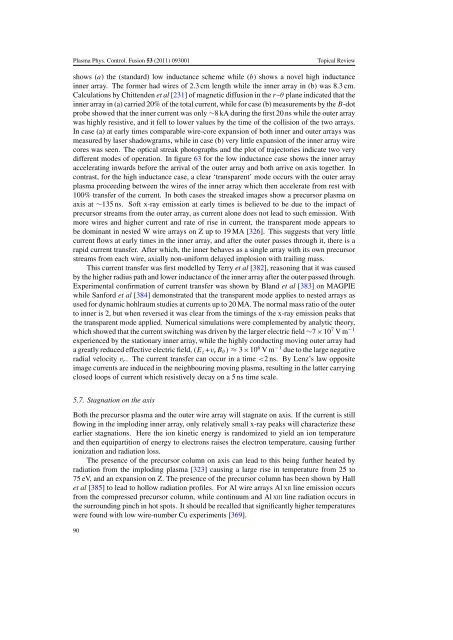You also want an ePaper? Increase the reach of your titles
YUMPU automatically turns print PDFs into web optimized ePapers that Google loves.
Plasma Phys. Control. Fusion 53 (2011) 093001<br />
Topical Review<br />
shows (a) <strong>the</strong> (standard) low inductance scheme while (b) shows a novel high inductance<br />
inner array. The former had wires <strong>of</strong> 2.3 cm length while <strong>the</strong> inner array in (b) was 8.3 cm.<br />
Calculations by Chittenden et al [231] <strong>of</strong> magnetic diffusion in <strong>the</strong> r–θ plane indicated that <strong>the</strong><br />
inner array in (a) carried 20% <strong>of</strong> <strong>the</strong> total current, while for case (b) measurements by <strong>the</strong> B-dot<br />
probe showed that <strong>the</strong> inner current was only ∼8 kA during <strong>the</strong> first 20 ns while <strong>the</strong> outer array<br />
was highly resistive, and it fell to lower values by <strong>the</strong> time <strong>of</strong> <strong>the</strong> collision <strong>of</strong> <strong>the</strong> two arrays.<br />
In case (a) at early times comparable wire-core expansion <strong>of</strong> both inner and outer arrays was<br />
measured by laser shadowgrams, while in case (b) very little expansion <strong>of</strong> <strong>the</strong> inner array wire<br />
cores was seen. The optical streak photographs and <strong>the</strong> plot <strong>of</strong> trajectories indicate two very<br />
different modes <strong>of</strong> operation. In figure 63 for <strong>the</strong> low inductance case shows <strong>the</strong> inner array<br />
accelerating inwards before <strong>the</strong> arrival <strong>of</strong> <strong>the</strong> outer array and both arrive on axis toge<strong>the</strong>r. In<br />
contrast, for <strong>the</strong> high inductance case, a clear ‘transparent’ mode occurs with <strong>the</strong> outer array<br />
plasma proceeding between <strong>the</strong> wires <strong>of</strong> <strong>the</strong> inner array which <strong>the</strong>n accelerate from rest with<br />
100% transfer <strong>of</strong> <strong>the</strong> current. In both cases <strong>the</strong> streaked images show a precursor plasma on<br />
axis at ∼135 ns. S<strong>of</strong>t x-ray emission at early times is believed to be due to <strong>the</strong> impact <strong>of</strong><br />
precursor streams from <strong>the</strong> outer array, as current alone does not lead to such emission. With<br />
more wires and higher current and rate <strong>of</strong> rise in current, <strong>the</strong> transparent mode appears to<br />
be dominant in nested W wire arrays on Z up to 19 MA [326]. This suggests that very little<br />
current flows at early times in <strong>the</strong> inner array, and after <strong>the</strong> outer passes through it, <strong>the</strong>re is a<br />
rapid current transfer. After which, <strong>the</strong> inner behaves as a single array with its own precursor<br />
streams from each wire, axially non-uniform delayed implosion with trailing mass.<br />
This current transfer was first modelled by Terry et al [382], reasoning that it was caused<br />
by <strong>the</strong> higher radius path and lower inductance <strong>of</strong> <strong>the</strong> inner array after <strong>the</strong> outer passed through.<br />
Experimental confirmation <strong>of</strong> current transfer was shown by Bland et al [383] on MAGPIE<br />
while Sanford et al [384] demonstrated that <strong>the</strong> transparent mode applies to nested arrays as<br />
used for dynamic hohlraum studies at currents up to 20 MA. The normal mass ratio <strong>of</strong> <strong>the</strong> outer<br />
to inner is 2, but when reversed it was clear from <strong>the</strong> timings <strong>of</strong> <strong>the</strong> x-ray emission peaks that<br />
<strong>the</strong> transparent mode applied. Numerical simulations were complemented by analytic <strong>the</strong>ory,<br />
which showed that <strong>the</strong> current switching was driven by <strong>the</strong> larger electric field ∼7×10 7 Vm −1<br />
experienced by <strong>the</strong> stationary inner array, while <strong>the</strong> highly conducting moving outer array had<br />
a greatly reduced effective electric field, (E z +v r B ϑ ) ≈ 3×10 6 Vm −1 due to <strong>the</strong> large negative<br />
radial velocity v r . The current transfer can occur in a time














